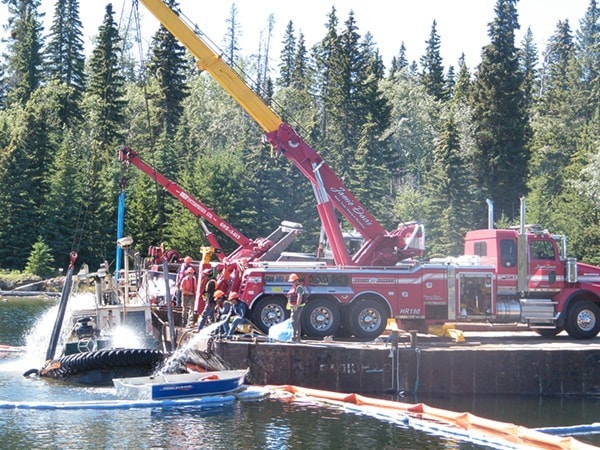Spoiler alert. If you’re a fan of Highway Thru Hell, the Discovery Channel documentary television series that focusses on Hope B.C.’s Jamie Davis and his high-risk Coquihalla highway recovery operation, the following will take the drama out of an upcoming episode.
Four months ago, the Cheslatta-Carrier Nation (CCN) discovered that two of their tug boats, the Davis Straits and the Valerie, had been sunk at their winter mooring in Forestry Bay, beside the old Cheslatta sawmill site on Ootsa Lake.
After initial environmental cleanup, the vessels remained in place as Cheslatta and their insurance company worked out a recovery plan.
Davis was recently returning from the Fort McMurray area where he has set up a branch of his business and is filming for upcoming seasons.
It was perfect timing for him to pull into Burns Lake on his way back to Hope, if logistics could be ironed out quickly enough.
James Rakochy, incident commander and CCN land and resource manager, was able to co-ordinate with local forestry and specialized logging contractor Quinten Beach to set up an open-water barge system to accommodate the heavy recovery equipment needed to get the tugs off lake bottom.
Beach Marine Inc., Beach’s underwater logging outfit, took over the logistics for extraction in co-ordination with Prince Rupert’s Adams Diving and Marine Services for underwater rigging, and local forestry contractor DWB for environmental services.
Davis’ 600 hp Rotator HR 150 is the king of heavy duty extraction and recovery. Made famous in his television series, it has the mobility of a tow-truck with the lifting power of a boom-armed, swing crane. And all of this without the regulations which limit the usefulness of larger ‘crane-designated’ units.
“We can take this into situations where a larger crane wouldn’t be able to go,” Davis said.
The boom lift is rated for 75 tonnes at minimal extension and up to 36,000 pounds at full extension.
The weight of the sunken vessels was not exactly known, but it was never a concern as local towing contractor BKV Enterprises Ltd. was also on hand with his 35-tonne heavy recovery truck to reinforce the lift.
Davis said that the biggest issue wasn’t likely to be the weight of the boat, but overcoming the suction created between accumulated lake-bottom silt and the boat.
After loading both tow trucks onto two barges lashed together, Beach Marine Inc. swung the barges into place over the sunken boats. With a large, on-barge excavator anchoring the barges in place and two small river tugs making fine adjustments, members of Adams Diving were able to secure recovery straps stretched from the trucks to anchor points on the Davis Straits.
Slowly, Davis and BKV Towing hoisted the boat until it broke surface. Once partially out of the water, Beach’s crew secured any open boat hatches and began pumping out hull water with three bilge pumps.
Within an hour of starting to empty the hull, it was floating on its own. After an inspection by ministry authorities, the boat was towed to shore where contaminated water was emptied into containers for safe disposal.
Very little engine fluid came up during the lift. Care was taken to keep bilging within a perimeter of hydro-carbon absorbent materials.
Representatives from the Department of Fisheries, the Ministry of Environment, Emergency Response B.C., the Coast Guard, and the Conservation Officer Service were on hand to observe the recovery.
The second vessel - the Valerie - was also raised, as well as a barge that had gone underwater some time ago.
Rakochy later said that the reasons for the tugs sinking remain undetermined at this time, even after an initial inspection once the tugs were raised.
“We will hopefully have the smaller vessel, the Valerie, in service this season,” said Rakochy, “but don’t know about the Davis Straits as it is a more daunting task.”
Total costs for the lift are not yet determined, but insurance is expected to offset some of the expense. Very preliminary estimates put all costs, from the time of the sinking to getting the boats going again, well over $100,000.
